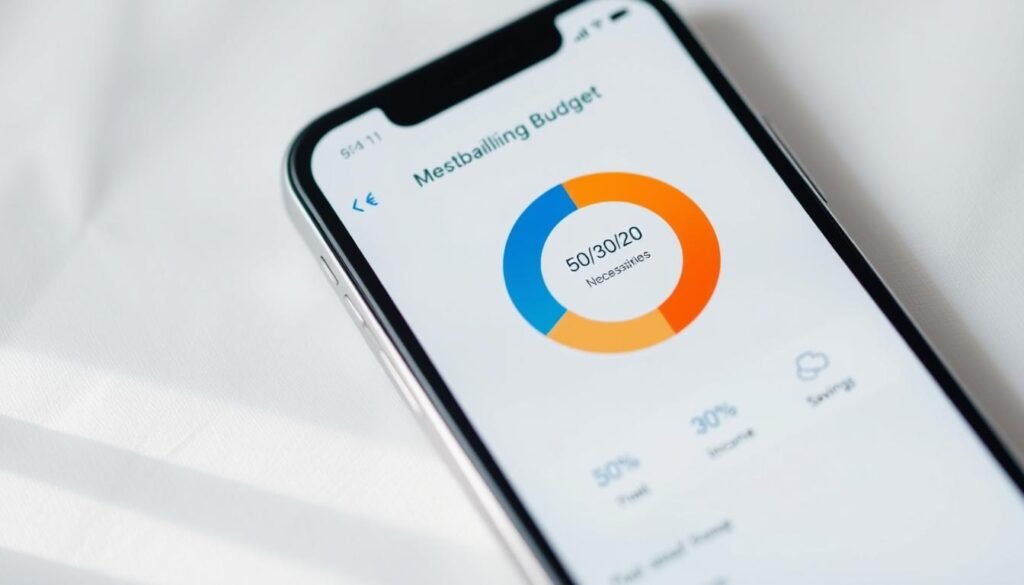Are you tired of living paycheck to paycheck? Managing your finances well can change your life. Simple budgeting strategies can help you control your money and reach financial stability.
Imagine being able to save for the future and still enjoy your favorite things. Decorating your home with beautiful accessories is possible. Start with the 50/30/20 rule, dividing your income into needs, wants, and savings.
These genius budget hacks will simplify your financial life. You’ll make the most of your money.
1. The50/30/20 Rule: Simplify Your Budgeting Approach
The 50/30/20 rule is a simple way to manage your money. It divides your income into three parts: 50% for needs, 30% for wants, and 20% for savings and debt. This helps you keep track of your spending and save for the future.
Breaking Down Your Income into Needs, Wants, and Savings
First, you need to know what each part of the 50/30/20 rule means. Needs are things like rent, utilities, and food. Wants are things like going out to eat, entertainment, and hobbies. Savings and debt repayment are for building an emergency fund, saving for retirement, and paying off debts.
For example, when you want to decorate your living room or bedroom, this rule helps. You can plan your budget for decor and stay within your means.
| Category | Percentage | Example Expenses |
|---|---|---|
| Needs | 50% | Rent, Utilities, Groceries |
| Wants | 30% | Dining Out, Entertainment, Hobbies |
| Savings & Debt Repayment | 20% | Emergency Fund, Retirement Savings, Debt Repayment |
Adjusting the Percentages for Your Unique Situation
The 50/30/20 rule is a good starting point, but you might need to adjust it. For example, if you have a lot of debt, you might put more than 20% towards paying it off. If you live in a place with high costs, you might need to spend more on needs.
Free Apps That Make 50/30/20 Tracking Effortless
There are free apps that can help you stick to the 50/30/20 rule. Apps like Mint, Personal Capital, and YNAB (You Need a Budget) can track your spending. They let you set budgets and get updates on how you’re doing.

2. Zero-Based Budgeting: Account for Every Dollar
Zero-based budgeting is a simple yet effective way to manage your money. It means giving every dollar a job. This way, every dollar is used for something important.

Why Giving Every Dollar a Job Eliminates Overspending
Assigning a role to every dollar makes you think twice about spending. It stops you from spending too much. Every dollar goes towards a goal, like saving for new furniture or paying off debt.
For example, if you want to decorate your living room, a zero-based budget helps. It lets you set aside money just for that. This way, you avoid buying things on impulse.
| Category | Allocated Amount | Actual Spend |
|---|---|---|
| Rent | $1,500 | $1,500 |
| Groceries | $500 | $450 |
| Decorative Home Items | $200 | $180 |
Step-by-Step Guide to Creating Your First Zero-Based Budget
To make a zero-based budget, follow these steps:
- List all your income sources.
- Write down all your expenses, like rent and utilities, and things you spend money on like entertainment.
- Put every dollar into a category, so your income minus expenses equals zero.
- Change categories if you need to reach your financial goals.
Monthly Reset: How to Adjust When Life Happens
Life can be unpredictable, and unexpected costs can pop up. To adjust your budget, check your expenses every month. Find areas to cut back and move money around as needed.
For instance, if you get a tax refund, you could save it or use it for something specific, like new furniture.
3. Cash Envelope System: The Visual Method to Control Spending
The cash envelope system is a simple way to manage money. It helps you avoid spending too much. You divide your money into categories and put it in labeled envelopes.

The Psychology Behind Physical Cash and Spending Awareness
Using cash can change how you spend money. It makes spending feel more real. This can help you avoid buying things on impulse.
For example, using cash when buying modern home accessories helps you stay within your budget. This is because you can see how much you have left.
Setting Up Your Envelope Categories for Maximum Impact
To use the cash envelope system, first list your spending categories. These might include groceries, dining out, and shopping for unique home decor.
- Choose categories that fit your spending habits.
- Decide how much money to set aside for each category.
- Fill an envelope for each category with the allocated cash.
Digital Envelope Systems for the Cashless Generation
If you prefer digital payments, there are digital envelope systems. They work like the cash system but use apps and online tools.
These tools let you create virtual envelopes for different spending areas. They help you manage your money even if you don’t use cash.
4. Automate Your Savings: Pay Yourself First
Paying yourself first is a simple yet effective strategy. It involves automating your savings to secure your financial future. By doing so, you ensure that you consistently set aside a portion of your income before spending on anything else. This approach helps in building a safety net and achieving long-term financial goals, such as purchasing stylish home accents or planning a dream vacation.

Setting Up Split Direct Deposits
One effective way to automate your savings is by setting up split direct deposits with your employer. This involves dividing your paycheck into multiple accounts, typically a checking account for immediate expenses and a savings or investment account. By allocating a fixed percentage of your income directly into savings, you reduce the likelihood of spending it on non-essential items. For instance, you could allocate 20% of your paycheck towards savings, ensuring that you prioritize your financial goals.
As financial expert Ramit Sethi once said, “The key is to automate your finances so you don’t have to think about it.” By setting up split direct deposits, you make saving easier and less prone to being neglected.
Micro-Saving Apps
In addition to split direct deposits, micro-saving apps have emerged as a popular tool for automating savings. These apps work by rounding up your purchases to the nearest dollar or a specified amount and transferring the difference into a savings account. For example, apps like Qapital and Digit allow you to save small amounts regularly, which can add up over time. This method is particularly useful for those who struggle to save large sums at once.
- Qapital: Offers a variety of savings rules, including rounding up purchases.
- Digit: Automatically transfers small amounts from your checking account to your savings.
- Acorns: Invests your spare change into a diversified portfolio.
Creating a “Forgot I Had It” Account
For long-term goals, consider creating a separate savings account that you rarely access, often referred to as a “Forgot I Had It” account. This account can be used to save for significant future expenses, such as updating your contemporary home decorations or buying home styling pieces. By keeping this account separate from your everyday spending money, you reduce the temptation to use these funds for non-essential purchases.
To make the most of this strategy, set up automatic transfers from your primary checking account to this dedicated savings account. Over time, you’ll accumulate a substantial amount without feeling the pinch, as the money is set aside before you have the chance to spend it.
5. Essential Budgeting Tips and Tricks for Grocery Shopping
Grocery shopping can be expensive, but you can save money with smart strategies. Planning, using tools, and making smart choices are key. This way, you can get quality without breaking the bank.

Strategic Meal Planning to Cut Food Waste by 50%
Meal planning is key to saving money and reducing waste. By planning your meals, you avoid buying too much and waste less food. This helps you stay within your budget and eat well.
- Plan meals based on what’s on sale.
- Use leftovers to cut down on waste.
- Keep a list of your favorite meals to make planning easier.
Stacking Cashback Apps, Store Rewards, and Manufacturer Coupons
Using different savings methods can help you save more on groceries. This includes cashback apps, store rewards, and manufacturer coupons. It’s a great way to stretch your budget.
- Download cashback apps like Ibotta or Fetch Rewards.
- Join store rewards programs for discounts and points.
- Clip digital or physical coupons for extra savings.
Price-Per-Unit Shopping: The Math That Saves Hundreds
Understanding the price per unit can help you shop smarter. This simple math can save you a lot of money over time.
- Check the unit price on the shelf label.
- Compare unit prices of different brands or sizes.
- Calculate total cost for bulk purchases to ensure savings.
By using these strategies, you can cut your grocery costs without feeling like you’re missing out. It’s all about being mindful of your spending and making a few simple changes.
6. Negotiate Everything: From Bills to Salary
Negotiating your bills and salary can change your financial future. It’s a skill that helps in many areas of personal finance. Learning it can save you money and even increase your salary.

Word-for-Word Scripts That Get Results with Service Providers
Using a script can help when negotiating with service providers. For example, you could say, “I’ve been a loyal customer for [X] years and always paid on time. I’m looking for a better rate; can you offer any discounts?” This shows you value the service but want a better deal.
Another good script is, “I’ve seen your competitors offer similar services cheaper. Can you match or beat that price?” This shows you’ve done your homework and are open to switching if needed.
Annual Bill Audit: Finding Hidden Fees and Unnecessary Services
Doing an annual bill audit is key to finding hidden fees and services you don’t need. Start by collecting all your bills and reviewing them. Look for any charges you don’t understand or services you’re not using.
| Service | Monthly Cost | Annual Cost |
|---|---|---|
| Streaming Service 1 | $15 | $180 |
| Streaming Service 2 | $10 | $120 |
| Gym Membership | $50 | $600 |
Subscription Tracking Tools That Identify Money Leaks
Subscription tracking tools can spot money leaks by checking your recurring subscriptions. Tools like Trim or Truebill can scan your bank statements and find forgotten subscriptions.
These tools help you decide which subscriptions to keep or cancel. You might find a service you no longer use, like a home decor subscription.
Negotiating bills and salary is more than saving money. It’s about controlling your finances. By using these strategies, you can greatly improve your financial health.
7. The24-Hour Rule: Defeating Impulse Purchases
The 24-hour rule is a simple yet effective way to stop impulse buys and save money. It means waiting 24 hours before buying something you don’t need. This helps you decide if you really need it.
When you see something you want to buy, like new living room decor, pause. Don’t buy it right away. Instead, add it to your wishlist or cart and wait.

Creating a Digital Wishlist Instead of Checking Out
Creating a digital wishlist is a smart move for the 24-hour rule. Most online stores let you save items for later. This way, you can:
- Avoid making impulse buys
- Compare prices across different sites
- Think about whether the item is something you really need
Setting Up Price Alerts for Items You’re Waiting On
Setting up price alerts for items on your wishlist is also helpful. Many online shopping platforms and third-party apps offer this feature. With price alerts, you’ll be notified if the price drops. This helps you:
| Feature | Benefit |
|---|---|
| Price Alerts | Notified of price drops |
| Price Comparison | Easy comparison across sites |
| Purchase Tracking | Reminders about items you’re interested in |
Questions to Ask Yourself During the Waiting Period
During the 24-hour waiting period, ask yourself a few important questions. This helps you make a better decision:
- Do I really need this item, or is it just something I want?
- Can I afford it within my current budget?
- Will this purchase align with my long-term financial goals?
By using the 24-hour rule and tools like digital wishlists and price alerts, you can cut down on impulse buys. This way, you make more thoughtful choices, even for tempting items like new living room decor.
8. Debt Snowball vs. Debt Avalanche: Choose Your Weapon
If you’re dealing with debt, you might wonder which method is best for you. The debt snowball and debt avalanche have their fans. Your choice depends on your financial situation and what you prefer.

Snowball Method: Small Wins for Motivation Seekers
The debt snowball method focuses on paying off debts from smallest to largest. This can give you quick victories, keeping you motivated. For example, if you owe $500 on a credit card and $10,000 on a car loan, start with the credit card.
Avalanche Method: Maximum Interest Savings for Math Lovers
The debt avalanche method targets debts with the highest interest rates first. This can save you more money in interest over time. For instance, if you have debts with 18% and 6% interest, tackle the 18% one first.
Hybrid Approaches That Combine the Best of Both Worlds
Some people mix elements of both methods for a hybrid approach. You might focus on interest rates but also get a psychological boost from quick wins. Just like picking the right bedroom accents, you can craft a debt plan that fits your goals and motivation.
The secret to success is sticking to your chosen method. Whether it’s the debt snowball, avalanche, or a mix, the key is to make a plan and follow it.
9. No-Spend Challenges: Reset Your Financial Habits
Trying a no-spend challenge can change how you handle money. It means not spending on things you don’t need for a while. This helps you know the difference between what you really need and what you just want.
A no-spend challenge is great for stopping impulse buys. This includes things like buying trendy home decor without thinking. By not spending on things you don’t need, you can save more money for important things.
Designing Your Challenge
To start a no-spend challenge, pick how long you want to do it. You can choose from a weekend to a month or more. It depends on your financial goals and how disciplined you are.
- Weekend challenge: Good for testing your willpower and finding areas to improve.
- Week-long challenge: Helps you start new spending habits.
- Month-long challenge: Has a bigger impact on your savings and spending awareness.
Creating a Fun “Allowed” and “Not Allowed” List
It’s important to make a list of what you can and can’t spend on. For example, you can buy basic groceries, but not eat out or buy fancy home decor.
| Category | Allowed | Not Allowed |
|---|---|---|
| Groceries | Essential food items | Dining out, takeout |
| Entertainment | Free or low-cost activities | Concerts, movies, expensive hobbies |
| Shopping | Necessities like toiletries | Clothing, accessories, luxury items |
Being clear about these categories helps you stay focused and makes the challenge more effective.
Tracking Your Savings and Celebrating Your Success
Keeping track of your progress is key to a successful no-spend challenge. Use a journal or a budgeting app to track your savings and see how your spending changes.
Reaching milestones, like a week without unnecessary spending, is something to celebrate. Treat yourself with something affordable, like a homemade meal or a DIY project with cheap home decor.

By the end of your no-spend challenge, you’ll understand your spending better and have a healthier financial view. You’ll be more careful with your money, including home decor, and make smarter financial choices.
10. The True Cost Method: Calculate Before You Buy
The true cost method is a game-changer for anyone looking to make more informed purchasing decisions. It’s not just about the initial price; it’s about understanding the full financial implications of your purchase. Whether you’re considering decorative home items or a major appliance, calculating the true cost can help you make more financially sound decisions.
The Work-Hour Calculator: Is This Purchase Worth Your Time?
One effective way to evaluate the true cost of a purchase is by using the work-hour calculator. This involves calculating how many hours you need to work to earn the money required for the purchase. For instance, if you’re considering a $500 decorative item and you earn $25 per hour, you’d need to work 20 hours to afford it. This perspective can help you decide if the item is worth your time and money.
Factoring in Lifetime Costs for Major Purchases
Major purchases often come with additional costs beyond the initial price. For example, when buying a new appliance, you should consider the cost of maintenance, repairs, and energy consumption over its lifetime. Here’s an example table to illustrate this:
| Purchase | Initial Cost | Lifetime Costs | Total Cost |
|---|---|---|---|
| Refrigerator | $1,000 | $500 (maintenance) + $800 (energy) | $2,300 |
| Decorative Home Items | $500 | $0 (assuming no additional costs) | $500 |
Creating a Value-Based Spending Framework
A value-based spending framework helps you align your purchases with your personal values and financial goals. To create one, start by identifying what’s important to you. Then, evaluate each potential purchase against these values. Ask yourself if the item aligns with your goals and if it’s worth the true cost. This framework can help you make more intentional purchasing decisions and reduce impulse buying.
By adopting the true cost method and incorporating tools like the work-hour calculator and value-based spending framework, you can make more informed financial decisions that align with your goals and values.
Conclusion: Transform Your Finances with These Budget Hacks
Using the budget hacks we’ve talked about can really help you manage your money better. Whether you want to add modern touches to your home or find unique decor, a good budget helps you make smart choices.
These tips let you spend on stylish items or new decor without hurting your finances. You can focus on what’s important, cut down on waste, and move closer to your money goals.
Start managing your money better today and build a safer financial future. With these budget hacks, you can make choices that fit your goals and values.



